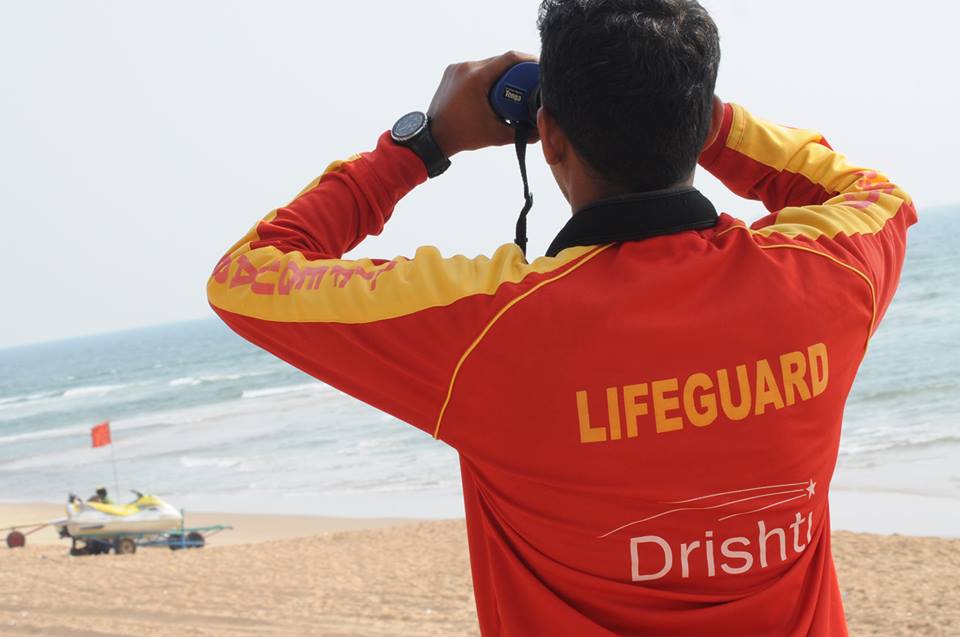With moderate and heavy rains lashing various parts of Goa, Drishti Lifesaving, the state-appointed professional lifeguard agency has issued a monsoon advisory instructing visitors to the beach not to venture into the sea during the monsoon months extending from June till the end of September.
According to the MET department, the southwest monsoon has advanced over Goa since 8th June and will intensify over the next few weeks. Pre-monsoon showers commenced in the state earlier this week with light to heavy showers witnessed across the state. With the onset of the monsoons the state will witness strong winds and thundershowers.
Drishti’s 700-strong lifeguard force man Goa’s beaches through the year. Owing to the oncoming monsoons and the present weather conditions, red flags have been posted across all beaches under Drishti’s surveillance indicating that these are strictly non-swim zones.
P.N. Pandey, General Manager (Operations), Drishti Lifesaving Pvt. Ltd. said “Pre-monsoon showers have already hit Goa. Over the past few days strong winds and showers were witnessed along the coastal stretch. With the onset of the monsoons the state will also witness strong winds, lightning and thundershowers. Accordingly, we advise visitors to the beach not to venture into the sea during the monsoon months. We have put up red flags at all the beaches which means that the area is not meant for swimming. Even wading into the waters is not advisable.”
Pandey added, “Our team of lifeguards present along the coast are monitoring the weather conditions. The team is trained to carry out rescues even in rough weather.”
In case of a dry spell over the next few months and depending on weather conditions, Drishti may open up a few beach stretches so that visitors can wade into the waters. Explained Pandey, “Goa’s coastline is quite complex and requires mapping every morning. If weather conditions are favourable, we may open up the zones on some of the beaches for visitors who want to wade into the water. These zones can be identified by the red and yellow flags and will be decided on a daily basis depending on the day’s weather. However, even in such conditions, swimming is not advisable due to the presence of under-water currents and rip tides.”
Pandey especially cautioned adults to keep a very close eye on children while on the beach and to not allow children to venture into the waters unattended, no matter how shallow it may be.
He further explained, “Goa’s beaches have a lot of monsoonal inlets at specific locations and the water run-offs generate strong rip currents which exists till the end of monsoons. It has been observed that during this season the tides are usually high and the tidal force is much more than normal because of the strong and gusty winds that increase the tide level. Also, the waves are higher than the regular waves while the underwater currents are much stronger during the monsoons”
Drishti Lifesaving checks the weather forecast with the IMD on a daily basis to keep a close tab on the weather conditions.
The Goa government shuts down the beaches for swimming and all water sports activities during the monsoon months from June to August each year as the sea during this season tends to be extremely rough and choppy. Goa will also be observing a 61-day fishing ban from 1st June to 31st July where nearly 1,500 trawlers will pull their nets off the territorial waters for the entire period of the ban.
#ListenToYourLifeguard: Safety tips for the monsoons by Drishti, Goa’s lifeguard agency:
- Those visiting the beach should keep minimum 10 meters away from the waterline and listen to the instructions given by the lifeguards.
- In case of a dry spell or no rainfall it is advised not to enter into the water above knee level in a swim zone which is marked with a red and yellow flag.
- Keep a very close eye on children while on the beach and do not allow children to venture into the waters unattended, no matter how shallow it may be.
- It is not advisable to venture into the water between 12 noon and 4pm. The sea is usually very rough in the afternoon because the wind pick up is more during this time.
- Avoid choosing a secluded beach which is not manned by a lifeguard. Instead pick a beach that is surrounded by people and never swim alone. Lifeguards are usually manning these areas.
- Stay alert as lifeguards while patrolling make announcements to alarm and educate people via the Public Address System put up on the jeeps.
- It is not suitable to head out to the beach or venture into the water during lightning and thunders because lightning can pose a danger.
- Do not get onto the rocks during low tide because the rocks get a lot more slippery and mossy during the monsoon season.
- It is not advisable to swim or to engage in any water sport activity at the beach during the monsoons months from June to September because even though the sea may seem calm, a sudden large wave can sneak up on you and pull you into deep waters without warnings.
- If under the influence of alcohol make sure you do not venture into the water.
- Always read and obey the safety signs found at the main entrance of the beach.


